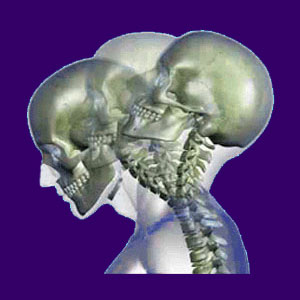
Whiplash is an unfortunate consequence of certain types of neck trauma. Any event which will snap the head forwards or backwards sharply has the chance of causing a neck injury. Most cases cervical hyperflexion and hyperextension are not severe, although they can be very excruciatingly painful, especially for the first 48 hours after occurrence.
Two of the main problems in receiving a sudden cervical injury are the nocebo effect of the diagnosis, as well as the societal acceptance of time-delayed pain. Both of these factors can exacerbate or perpetuate physical pain through the power of psychological programming. This is why it is so crucial to recognize the potential mindbody effects of any neck injury and not just focus exclusively on the physical anatomical consequences.
This resource details the occurrence of cervical traumas that are caused by acutely hyperextending and hyperflexing the neck.
Causes of Whiplash
The condition can be created from any violent shaking of the head and neck. The most common cause is an automobile accident. More specifically, rear impact collisions are the best source of neck pain related injuries. Falls, assaults, and sports injuries are also typical causes of this painful syndrome.
While it is possible for structural damage to be done to the spinal components, most cases merely involve soft tissue pain and related symptoms. However, neck and back muscle pain can still be a terrible ordeal to deal with, despite the temporary nature of the symptoms.
Whiplash neck pain is the most common expression of the condition, but many patients might also suffer related back pain.
Time Delayed Pain
This cervical injury condition, more than any other, is often associated with a substantial time delay in the onset of symptoms. There are usual reasons for this occurrence, based on medical science, psychology and sociology.
When a person is involved in an accident, there is a tremendous dose of adrenaline unleashed into their system. This causes certain anatomical and mental changes in the person, which can make them more resilient to pain.
Persons with significant injuries have been known to walk around seemingly unaffected for quite some time after a serious accident. Sometimes there is general pain and trauma throughout the body, which can make it rather difficult to pinpoint any specific area of injury, compared to simply being very “shaken up”.
Some injuries create inflammatory conditions which take some time to develop. As the injury swells over the course of hours, the pain can come on gradually or sharply all at once.
Psychological relief at having survived a serious accident can create elation which can also counteract pain. Sometimes the initial shock of any accident can distract the patient’s brain from experiencing severe pain until later on. Unfortunately, once treated, the patient is often given a nocebo effect when they are told that pain might come on at any time, sometimes up to 2 weeks later.
Combine this medical warning with the time it takes most persons to seek out a back injury lawyer and you have the perfect medical/legal combo for a time delayed pain syndrome. Personal accident attorneys are masters of subtle manipulation when it comes to interviewing potential clients for injury related cases. If the person was not in severe pain prior to talking to one of these master manipulators, it is a safe bet that symptoms will arrive shortly after the consultation. Funny how this always seems to happen.
Read more about delayed onset back pain.
Whiplash Guidance
Being both a martial arts instructor and an insurance investigator, I have extensive experience with neck and back injuries. In the dojo, these occurrences are common, especially in Judo, when a student is thrown and does not land correctly. Strikes and kicks to the neck and head are other famous causes of cervical and upper thoracic pain.
As an investigator, whiplash injuries are a nightmare. It is very difficult to determine a real deal injury from a well orchestrated or attorney-induced performance. I have seen some pretty good actors testifying in court and making a fortune from of their traumatic experience. I assure you that many of these plaintiffs were robbed by not receiving an Academy Award for their performance!
There is also the third very common scenario which accounts for a majority of persistent whiplash-related pain syndromes. These are the persons who were shaken up and maybe slightly injured, but are generally ok. Their doctors scared them to expect pain and the attorneys made sure they went to the “right” doctors for treatment. These doctors did everything possible to perpetuate the idea of a real injury and the expectation of ongoing chronic pain.
The doctor makes money. The attorney makes money. The patient might even make money. However, once the case is over, the patient rarely recovers and is left with a permanent disability caused almost completely through purposeful nocebo effect, rather than actual physical injury. It is a shame.
For additional information about back pain and the legal system, please read my page concerning back injury litigation.





